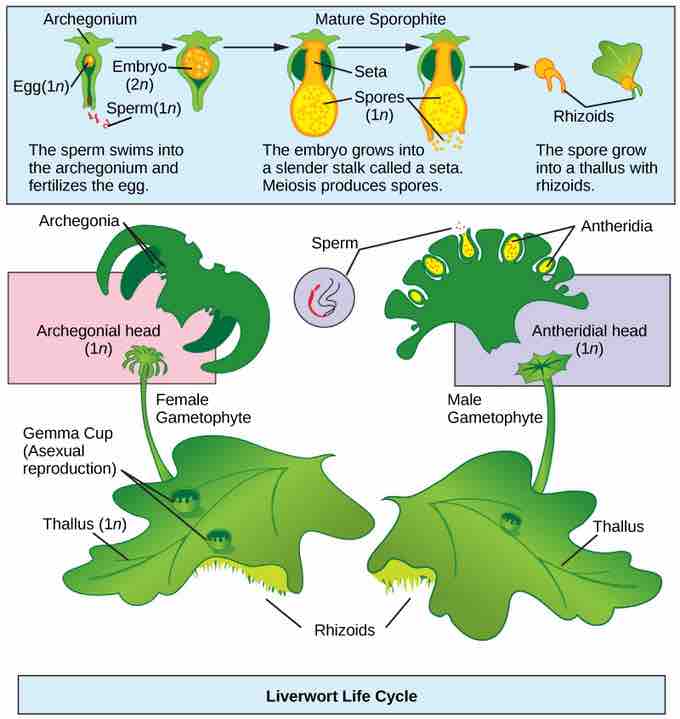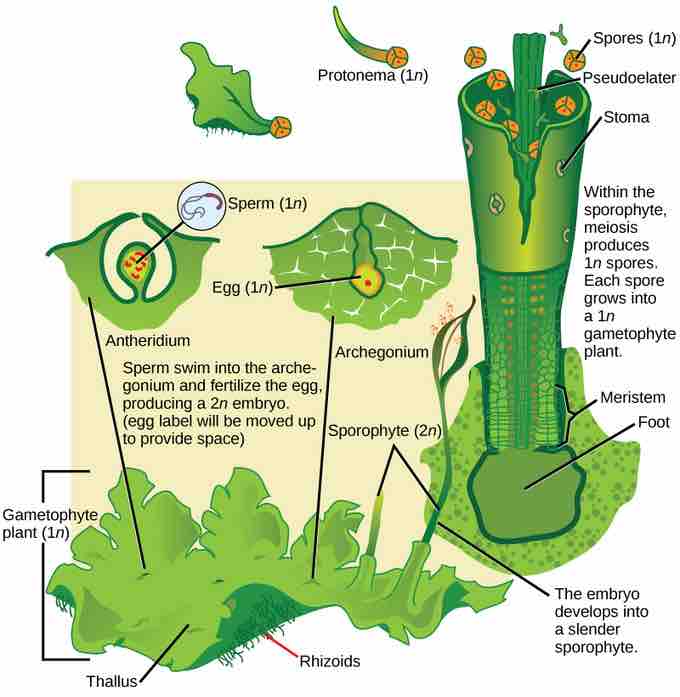Liverworts and Hornworts
Liverworts
Liverworts (Hepaticophyta) are viewed as the plants most closely related to the ancestor that moved to land. Liverworts have colonized every terrestrial habitat on earth and diversified to more than 7000 existing species. Liverwort gametophytes (the dominant stage of the life cycle) form lobate green structures . The shape of these leaves are similar to the lobes of the liver; hence, providing the origin of the name given to the phylum. Openings that allow the movement of gases may be observed in liverworts. However, these are not stomata because they do not actively open and close. The plant takes up water over its entire surface and has no cuticle to prevent desiccation.

Liverworts
A liverwort, Lunularia cruciata, displays its lobate, flat thallus. The organism in the photograph is in the dominant gametophyte stage.
The liverwort's life cycle begins with the release of haploid spores from the sporangium that developed on the sporophyte. Spores disseminated by wind or water germinate into flattened thalli gametophytes attached to the substrate by thin, single-celled filaments. Male and female gametangia develop on separate, individual plants. Once released, male gametes swim with the aid of their flagella to the female gametangium (the archegonium), and fertilization ensues. The zygote grows into a small sporophyte still attached to the parent gametophyte and develops spore-producing cells and elaters. The spore-producing cells undergo meiosis to form spores, which disperse (with the help of elaters), giving rise to new gametophytes. Thus, the life cycle of liverworts follows the pattern of alternation of generations .

Liverwort Life Cycle
The life cycle of a typical liverwort follows the pattern of alternation of generations. Spores are released from sporophytes and form the gametophyte. Male gametes fertilize female gametes to form a zygote, which grows into a sporophyte. This sporophyte disperses spores with the help of elaters; the process begins again.
Liverwort plants can also reproduce asexually by the breaking of branches or the spreading of leaf fragments called gemmae. In this latter type of reproduction, the gemmae (small, intact, complete pieces of plant that are produced in a cup on the surface of the thallus) are splashed out of the cup by raindrops. The gemmae then land nearby and develop into gametophytes.
Hornworts
The hornworts (Anthocerotophyta) belong to the broad bryophyte group that have colonized a variety of habitats on land, although they are never far from a source of moisture. The short, blue-green gametophyte is the dominant phase of the lifecycle of a hornwort. The narrow, pipe-like sporophyte is the defining characteristic of the group. The sporophytes emerge from the parent gametophyte and continue to grow throughout the life of the plant . Stomata appear in the hornworts and are abundant on the sporophyte. Photosynthetic cells in the thallus contain a single chloroplast. Meristem cells at the base of the plant keep dividing and adding to its height. Many hornworts establish symbiotic relationships with cyanobacteria that fix nitrogen from the environment.

Hornworts
Unlike liverworts, hornworts grow a tall and slender sporophyte.
The life cycle of hornworts also follows the general pattern of alternation of generations and has a similar life cycle to liverworts. The gametophytes grow as flat thalli on the soil with embedded gametangia. Flagellated sperm swim to the archegonia and fertilize eggs. However, unlike liverworts, the zygote develops into a long and slender sporophyte that eventually splits open, releasing spores. Additionally, thin cells called pseudoelaters surround the spores and help propel them further in the environment. Unlike the elaters observed in liverworts, the hornwort pseudoelaters are single-celled structures. The haploid spores germinate and produce the next generation of gametophytes . Like liverworts, some hornworts may also produce asexually through fragmentation.

Life Cycle of Hornworts
The life cycle of hornworts is similar to that of liverworts. Both follow the pattern of alternation of generations. However, liverworts develop a small sporophyte, whereas hornworts develop a long, slender sporophyte. Liverworts also disperse their spores with the help of elaters, while hornworts utilize pseudoelaters to aid in spore dispersal.